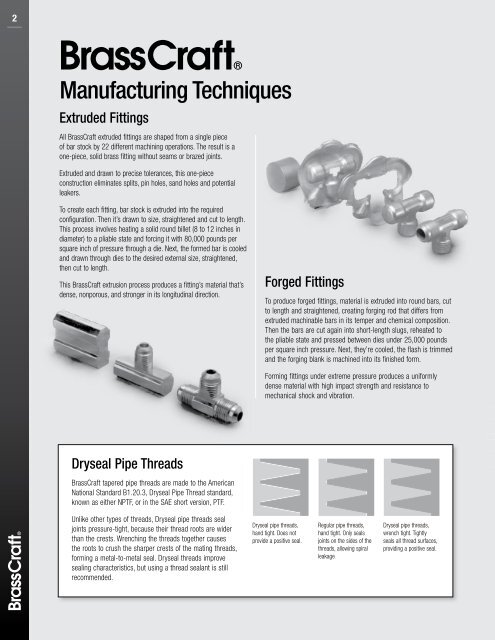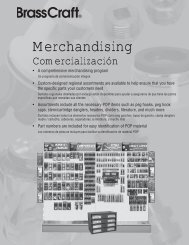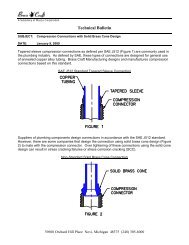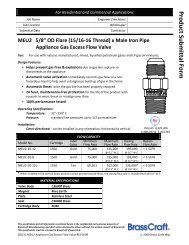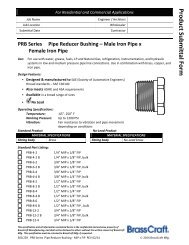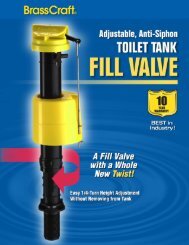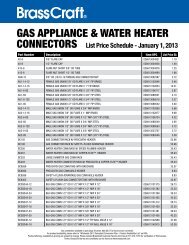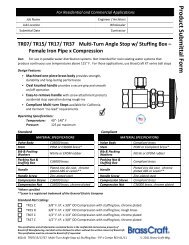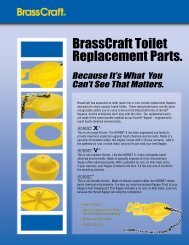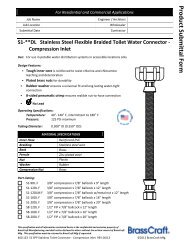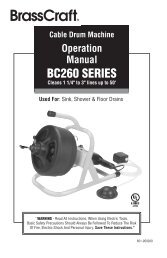Brass Fittings Catalog - Brass Craft
Brass Fittings Catalog - Brass Craft
Brass Fittings Catalog - Brass Craft
Create successful ePaper yourself
Turn your PDF publications into a flip-book with our unique Google optimized e-Paper software.
2<br />
Manufacturing Techniques<br />
Extruded <strong>Fittings</strong><br />
All <strong>Brass</strong><strong>Craft</strong> extruded fittings are shaped from a single piece<br />
of bar stock by 22 different machining operations. The result is a<br />
one-piece, solid brass fitting without seams or brazed joints.<br />
Extruded and drawn to precise tolerances, this one-piece<br />
construction eliminates splits, pin holes, sand holes and potential<br />
leakers.<br />
To create each fitting, bar stock is extruded into the required<br />
configuration. Then it’s drawn to size, straightened and cut to length.<br />
This process involves heating a solid round billet (8 to 12 inches in<br />
diameter) to a pliable state and forcing it with 80,000 pounds per<br />
square inch of pressure through a die. Next, the formed bar is cooled<br />
and drawn through dies to the desired external size, straightened,<br />
then cut to length.<br />
This <strong>Brass</strong><strong>Craft</strong> extrusion process produces a fitting’s material that’s<br />
dense, nonporous, and stronger in its longitudinal direction.<br />
Dryseal Pipe Threads<br />
<strong>Brass</strong><strong>Craft</strong> tapered pipe threads are made to the American<br />
National Standard B1.20.3, Dryseal Pipe Thread standard,<br />
known as either NPTF, or in the SAE short version, PTF.<br />
Unlike other types of threads, Dryseal pipe threads seal<br />
joints pressure-tight, because their thread roots are wider<br />
than the crests. Wrenching the threads together causes<br />
the roots to crush the sharper crests of the mating threads,<br />
forming a metal-to-metal seal. Dryseal threads improve<br />
sealing characteristics, but using a thread sealant is still<br />
recommended.<br />
Forged <strong>Fittings</strong><br />
To produce forged fittings, material is extruded into round bars, cut<br />
to length and straightened, creating forging rod that differs from<br />
extruded machinable bars in its temper and chemical composition.<br />
Then the bars are cut again into short-length slugs, reheated to<br />
the pliable state and pressed between dies under 25,000 pounds<br />
per square inch pressure. Next, they’re cooled, the flash is trimmed<br />
and the forging blank is machined into its finished form.<br />
Forming fittings under extreme pressure produces a uniformly<br />
dense material with high impact strength and resistance to<br />
mechanical shock and vibration.<br />
Dryseal pipe threads,<br />
hand tight. Does not<br />
provide a positive seal.<br />
Regular pipe threads,<br />
hand tight. Only seals<br />
joints on the sides of the<br />
threads, allowing spiral<br />
leakage<br />
Dryseal pipe threads,<br />
wrench tight. Tightly<br />
seals all thread surfaces,<br />
providing a positive seal.<br />
Note: Special fitting configurations and sizes may be ordered. Please furnish a print or sketch of your needs with your inquiry.


